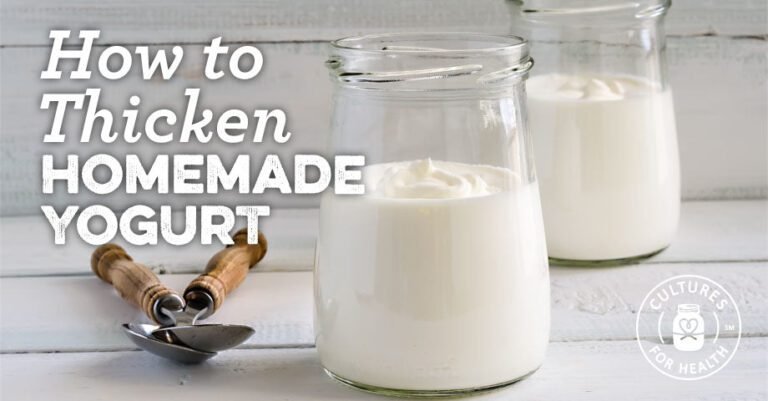Thick Yogurt | How can I make yogurt thicker? – Culture for health
– | / Save up to % keep Save up to % keep Sale Sold Out In Stock
Mastering yogurt culture techniques is a rewarding process, but you may be wondering, “Why is my yogurt so watery?” You may want to thicken your homemade yogurt to enhance its texture.
We want to help you make delicious and healthy yogurt according to your needs. Download our yogurt guide and recipe book. We’ve listed an easy solution for watery yogurt so you can have the ideal snack any time of the day.
Know when to thicken yogurt
Using reusable starter cultures
If you make it using yogurt, heirloom starter culture Activation is often required. activation badge somewhat liquid and thin.
This is completely normal, as the bacteria in the freeze-dried culture are just waking up and becoming active during the first batch. You may be tempted to reach for a thickener, but remember that even if the milk is runny, it’s still cultured and can be used to culture future batches.
During the next few batches, It should be even in texture and consistency. If you still prefer thicker yogurt after a few tries, consider thickening your yogurt using one of the methods below.
In some cases, thickeners prevents re-culture, So if you plan on experimenting with different thickeners, keep plenty of starter yogurt on hand.
Using a vegan yogurt starter culture
On the other hand, if you use yogurt, Vegan yogurt starter cultures are direct set (or disposable) cultures. thickener to help solidify. Some of the thickeners below Be sure to choose a thickener before you start, as it must be added to the milk before heating and culturing. of The vegan yogurt starter kit comes with a thickener to help you get the perfect texture.

1. Try starter or milk
Depending on the type of milk used and the culture chosen, yogurt can be: thin like buttermilk or as Thick like sour cream. Two ways to increase the thickness of the final product are to choose a different type of milk to make yogurt or to choose the best yogurt starter for your application.
To increase the thickness of the final product, choose a different type of milk or choose the best yogurt starter for your application. This allows you to make your homemade yogurt as thick as you like.
2. Increase fat content
The fat in yogurt is part of what makes it thick. whole milk as a result thick yogurt than skim milk.
Also, add cream It can be mixed with milk or used in place of milk to increase the fat content. Fresh cream has too little lactose In order to maintain the heirloom culture for a long time, be sure to refresh starter of Whole milk or 2% milk after 2-4 batches If you decide to use this.
3. Heat the milk longer
Warm the milk when making it Maintain a temperature of 160°-180°F. About 20 to 30 minutes. after that nice up to culture temperature.
(If milk is accidentally heated above 180°F, cool it to 180°F before maintaining the temperature.)
When milk is heated, proteins denature, stronger network When exposed to acids (such as lactic acid produced by bacteria in yogurt cultures). therefore, Maintains higher temperature for a certain period of time give you longer time Hard yogurt.
The important thing is Warm milk slowly to make creamy yogurt. Overcooking milk will give it a grainy texture.
By doing so, the proteins in the milk denature and form a stronger network when exposed to acid. Now you can master how to thicken yogurt.
5. Add thickener!
This is the most successful process. culture set directly, or when Maintain a separate mother culture as thickeners can interfere with re-cultivation. Yogurt will not thicken until it cools. Especially dairy-free yogurt. In some cases, thickening may take longer Up to 24 hours. Yogurt can be eaten even if it is thin because it is a cultured food (perfect for whipping). Smoothie! )
Different yogurt thickeners and their uses
Powdered milk solids typically come in cow, goat, and soy varieties.
When to add: Add to milk before heating and culturing.
Procedure: In all cases 3-4 cups fresh milk use 1/2 to 1 cup powdered milk. If using fresh goat milk or soy milk Add 1/4 to 1/2 cup of powdered milk.
Advantages: No additional heating or additives required. No other ingredients are introduced.
Cons: Powdered milk is processed, so you may choose to avoid it. This thickener is not suitable for raw yogurt.
When to add: Add to milk before heating and culturing.
Procedure: In all cases 3-4 cups of milk, sprinkle 1 tablespoon gelatin Add to 1 cup of cold milk. Gelatin is a must Heat to at least 95⁰F to activate. Mix well to combine. For yogurt incubated at room temperature, be sure to cool the milk to incubation temperature. Before adding the starter culture.
Pros: Achieves very thick, commercial-style textures. Neutral taste. It is suitable for raw milk yogurt as it does not need to be heated above the raw threshold.
Cons: Not suitable for vegetarians or vegans.
When to add: Prepare thickener in milk before heating and culturing.
How to make: For making 1 quart pour yogurt 2 cups milk into a blender. addition 1-2 teaspoons pectin (depending on the type of pectin), blend until the pectin is incorporated. addition with the remaining milk Heat to 140⁰F. nice Culture temperature and Add culture.
Please note: Depending on the milk and pectin you use, you may need to adjust the amount of pectin. Additional sugar may be needed in the milk for sugar-activated pectin to be effective. calcium activated pectin It uses the calcium contained in milk to solidify it. If using non-dairy milk, add the amount of calcium water specified in the recipe.
Strong Points: Perfect for vegan yogurt. Consistent results. It will have a texture similar to gelatin and will be very thick.
Cons: Pomona’s isn’t available at every grocery store (but Find it here or at vegan yogurt starter kit). Not suitable for people with citrus allergies. Standard (sugar-set) pectin greatly affects the flavor of yogurt and requires large amounts of sugar. Not suitable for making raw yogurt.
When to add: Add to milk before heating and culturing.
Instructions: for everyone Melt 3-4 cups of milk 1/2 teaspoon powdered agar into milk. heat to 190⁰F and wait a while 10 minutes. nice Culture temperature and Add culture.
Strong Points: A great vegan option with low allergens.
Cons: Texture can be unstable. Requires longer heating time to work properly. Not suitable for making raw yogurt.
If you add: Add to milk before culture or yogurt after culture.
Instructions: for everyone Add 3-4 cups of milk 1 teaspoon guar gum Place in cold milk before heating and culturing. (You can also add it to milk after heating, but let the milk cool first.) Alternatively, add 1 teaspoon of guar gum per 3 to 4 cups of cultured yogurt.
Advantages: Can be added after the yogurt has been incubated. It is suitable for making fresh yogurt as it does not require heating.
Cons: The texture is not as smooth as other methods. Must be thoroughly blended to avoid lumps.
When to add: Add to milk before heating and culturing.
Instructions: for Melt 3-4 cups of milk 2 tablespoons tapioca starch Put it in milk heat to 140⁰F. nice Culture temperature and Add culture.
Pros: Easier to find than some products. A good option for vegans.
Cons: It can be very inconsistent. It will fail if it overheats, but it must reach at least 140⁰F to work.
When to add: Add to milk before heating and culturing.
Instructions: for 3-4 cups of Dissolve non-dairy milk Arrowroot starch 1 1/2 to 2 tablespoons Put it in milk heat to 140⁰F. nice Culture temperature and Add culture.
Strong Points: A good choice for non-dairy milk.
Cons: Not recommended for use with dairy products.
ultra gel (Processed cornstarch)
When to add: Add to cooled milk after heating and before culturing.
Regular cornstarch can also be used, but it is not particularly stable and may give you a strange consistency.
Instructions: for 3-4 cups milk, add Ultra Gel 1/4 cup into milk rear has been heated and It got cold. mix Combine well.
Strong Points: It doesn’t seem to require any heat to operate. Easy to find. Get consistent results.
Cons: Highly processed.
How to keep yogurt from getting too thick
You may be tempted to add more cultures to your yogurt to increase its probiotic content; rarely succeeds.
Yogurt culture is carefully balanced So the strains work together to give you a special result in terms of taste and consistency. Adding more strains can weaken or kill the yogurt culture, and it can also produce something harmful if eaten.
So when working with yogurt starter cultures, try any of the methods above to thicken your homemade yogurt to your liking.
Start making homemade yogurt with culture for health
Cultivating your own yogurt is a great way to make great yogurt at home without all of the unnatural ingredients that many companies use in pre-made yogurt. Everyone loves freshly cultured yogurt, but it can be difficult to store correctly and maintain consistency. Luckily, we’ve explained exactly how to thicken yogurt and how not to thicken yogurt.
With all this in mind, I think it’s time to go back. Make your own yogurt. If you haven’t started yet, now is the perfect time. Cultures for Health can help.
We take all the guesswork out of fermentation. All-in-one fermentation kit Contains everything you need to make meals at home.
Are you a veteran in the fermentation game? Well, our services have you covered too great yogurt starter pack and wide range of tools Add it to your fermentation kitchen.
Click here to check out our vegan yogurt starter kit and start making your own homemade yogurt today!
Looking for a delicious, healthy snack that’s easy to make? Download our yogurt guide and recipe book to get started today!

Ready to learn more?
{“themeColor”:”#7892a4″,”iconColor”:”#7892a4″,”showLogo”:false,”topBottomPosition”:10,”rightLeftPosition”:10,”iconSize”:”large”,”iconCustomSize”:64 ,”position”:”top left”}


